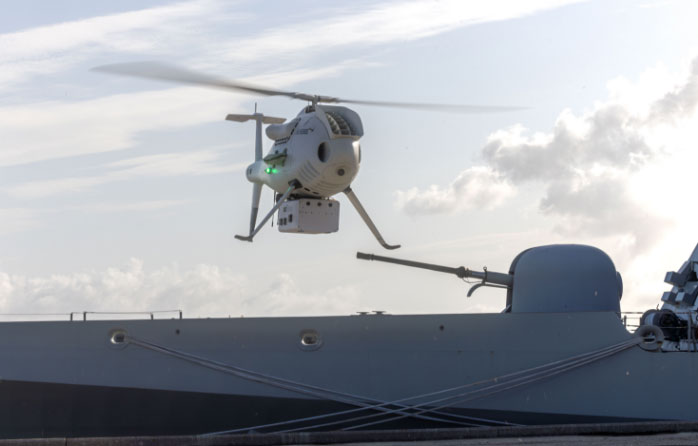

As the threat of sea mines makes a resurgence and leading navies move towards deploying arrays of uncrewed systems for MCM operations, Shephard looks at the contribution of UAS to a multi-domain network of autonomous and remotely operated vehicles active above, on and below the waves.
As militaries look to a future of multi-domain operations, many are exploring potential applications for UAVs in naval operations. Mine countermeasures (MCM) are one such focus.
The use of uncrewed assets equipped with payloads for both detection and/or neutralisation of mines is becoming a go-to solution for the defence industry around the globe, according to Neil Hunter, global head of sales at Schiebel.
‘The simultaneous and complimentary deployment of manned assets, such as ships, with unmanned airborne and waterborne vehicles, enables a safe and efficient detection of mines,” he said.
Hunter noted that Schiebel’s Camcopter S-100 is designed to carry a variety of sensors that could be used for mine detection, such as a bathymetric LIDAR scanner. The company demonstrated two such payloads during NATO’s REPMUS 2023 exercise: the Riegl VQ-840-G (in a demonstration with Thales) and Fugro’s Rapid Airborne Multibeam Mapping System (RAMMS) LIDAR (alongside Areté), with both demonstrations involving rapid environmental assessment and mine detection.
“Through the open architecture of the Thales MCM mission management system (M-Cube), the Camcopter S-100 was able to perform a complete airborne MCM mine hunting capability, achieving 100% detection of all mine targets,” Hunter said.
When equipped with the VQ-840-G, the S-100 ‘carried out laser range measurements for high-resolution surveying of underwater topography with a narrow, visible green laser beam, emitted from a pulsed laser source. This enabled the mapping of coastlines and shallow waters and subsequently the detection of potential mines,’ Hunter said.
Additionally, he said that high-resolution EO/IR cameras can also be used effectively by UAVs to find moored mines below the surface in relatively low water levels.
The flights with RAMMS saw the S-100 map areas that could not be safely accessed by crewed surface assets, specifically in shallow water. Additionally, another exercise during REPMUS 2023 saw the S-100 use its cargo hook to deliver and deploy a Seaber YUCO AUV, plus a Teledyne Webb APEX profiling float.
“Both unmanned surface vehicles were used to produce a topobathymetric situational picture with the data being sent to the S-100 for dissemination or directly to a ship’s combat management system (CMS),” said Hunter.
